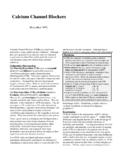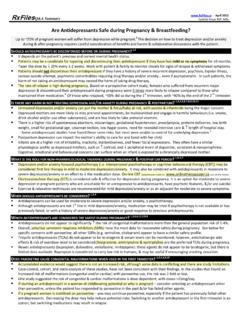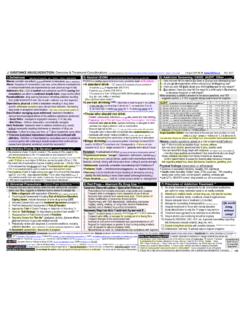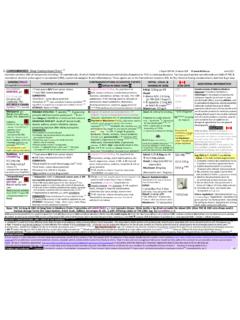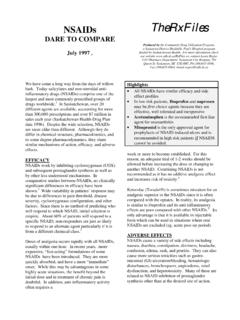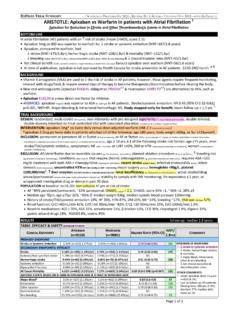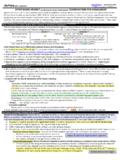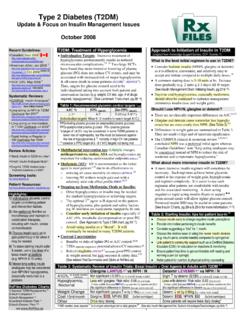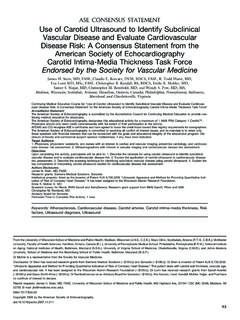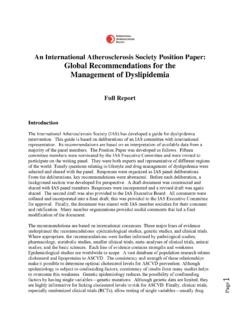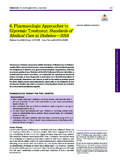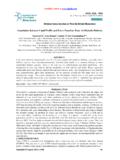Transcription of RXFILES TRIAL SUMMARY WWW JULY 2016; UPDATED MAY …
1 RXFILES TRIAL SUMMARY JULY 2016; UPDATED MAY 2017 Page 1 of 3 LEADER: Liraglutide VICTOZA CV Outcomes TRIAL Summary1 Liraglutide: cardiovascular (CV) Outcomes and Mortality in Patients with Type 2 Diabetes (T2DM) In patients with T2DM and at high risk of CV events, does liraglutide reduce CV risk compared to placebo when added to standard care? BOTTOM LINE Liraglutide is the first drug of its class (GLP1 A) to demonstrate positive CV outcomes in a RCT. Compared to standard care, for every 100 patients with T2DM and high CV disease risk, treatment with liraglutide for ~4 years will result in 2 less CV events (composite endpoint of: CV death (significant), nonfatal stroke (NS), nonfatal MI (NS)), 2 less cases of nephropathy, but 1 extra case of acute gallbladder disease, and 2 extra cases of discontinuation due to adverse events such as nausea, vomiting and diarrhea.
2 Liraglutide resulted in an additional ~ weight loss over the placebo group, and also affected BP (SBP mmHg, DBP mmHg), and heart rate ( 3 BPM). Areas of caution: Previous trials with similar drugs, designs and endpoints had only neutral Although CV benefit demonstrated with 6 Liraglutide is rather new; too early to be certain of long term effects ( , pancreatic and thyroid carcinoma). Cost may be prohibitive to some patients (~$690 for 100days and currently not covered on SK or NIHB formularies). BACKGROUND Liraglutide (VICTOZA $750/100days) is a glucagon like peptide 1 agonist (GLP1 A) approved in 2010 for use in patients with T2DM as add on to metformin alone, metformin+SU, metformin+basal Non inferior outcome TRIAL mandated by the FDA to ensure CV safety in the post rosiglitazone era.
3 3 TRIAL BACKGROUND1,4 6 DESIGN: Randomized, double blind, placebo controlled, international (32 countries) multi centre (410 sites) TRIAL with a 2 week run in phase. Non inferiority analysis for primary efficacy outcome followed by superiority analysis (ITT population). Funding: Novo Nordisk (VICTOZA manufactuer) & National Institutes of Health. Enrollment/Follow up period: 2010 2015. INTERVENTION: Liraglutide subcut daily vs. placebo, added to existing therapy. patients were randomized to liraglutide mg subcut daily and titrated after 2 weeks to a maximum of based on tolerance (median dose ). If patient did not reach recommended target for glycemic control (HgA1c 7% or individualized target at investigator s discretion), addition of antihyperglycemics (except GLP1 A DPP4 I, and pramlintide) including insulin, were permitted.
4 INCLUSION: T2DM, HbA1c > , >50 years old with >1 CV condition (CHD, cerebrovascular disease CKD > stage 3, HF NYHA class II III, PVD) or >60 years old with > 1 CV risk factor (microalbuminuria, proteinuria, HTN+LVH, LV dysfunction, ABI of < ). EXCLUSION: T1DM; use of: GLP1 A, DPP4 I, pramlinitide, rapid acting insulin; familial/personal history of multiple endocrine neoplasia type 2 or medullary thyroid cancer, acute ( 14 days) coronary or cerebrovascular event or planned revascularization. POPULATION: randomized: n=9340 ~64% , 77% Caucasian, age + yrs, duration of diabetes ~ +8 yrs, HgA1c + , BMI + kg/m2, SBP + mmHg, DBP + mmHg CV comorbidity/risk factors: MI ~ , stroke or TIA ~ , revascularization ~39%, >50% stenosis (coronary, carotid, lower extremity arteries) , HF NYHA class II III ~14%, CKD (eGFR <60 mL/ ) ~ , microalbuminuria or proteinuria ~ , HTN+LVH ~ , LVH ~ , ABI < Medications: on antihypertensives ( BB, 51% ACEI, ARBs, 32% CCB [some patients were on multiple agents ]), 72% on statins, on ASA, on other antiplatelet agent, on metformin, on SU, on TZD, and on insulin.
5 RESULTS Follow up: yrs (median) TABLE 1: EFFICACY & SAFETY PRIMARY & SECONDARY ENDPOINTS CLINICAL ENDPOINTS ITT ANALYSIS LIRAGLUTIDE SUBCUT DAILY n=4668 PLACEBO n=4672 HR 95% CI P VALUE ARR/ARINNT/NNH COMMENTS PRIMARY ENDPOINT First occurrence of death from cardiovascular causes, nonfatal MI or stroke 13% (n=608) (n=694) ( ) (superiority)< (non inferiority) 53 Composite endpoint primarily driven by in CV death (other components were NS). EXPANDED ENDPOINTS Death from CV causes (n=219) (n=278) ( ) 77 Death from any cause (n=381) (n=447) ( ) 72 Non fatal MI (n=281) (n=317) ( ) Non fatal stroke (n=159) (n=177) ( ) Hospitalization for HF (n=218) (n=248) ( ) Analysis at 36 months shows a mean difference of % in the liraglutide vs placebo group (95% CI, to ) for HbA1c.
6 MICROVASCULAR ENDPOINTS Nephropathy (n=268) (n=337) ( ) 67 Retinopathy (n=106) (n=92) ( ) = Nephropathy = new onset of MACRO albuminuria or doubling of SCr and eGFR <45ml/ or need for continuous RRT. RXFILES TRIAL SUMMARY JULY 2016; UPDATED MAY 2017 Page 2 of 3 TABLE 2 ADVERSE EVENTS (AE) CLINICAL ENDPOINTS LIRAGLUTIDE SUBCUT DAILY n=4666 PLACEBO n=4672 P VALUE ARR/ARI NNT/NNH COMMENTS ACUTE GALLSTONE DISEASE (n=145) (n=90) < 84 ANY AE LEADING TO DISCONTINUATION FROM TRIAL (n =444) (n=339) < 46 SEVERE HYPOGLYCEMIA (n=114) (n=153) 111 SEVERE ADVERSE EVENTS (n=1502) (n=1533) ANY MALIGNANT NEOPLASM (n=296) (n=279) SAE PANCREATIC CARCINOMA (n =13) (n =5) NAUSEA (n=77) (n=18) < 84 VOMITING (n =31) < (n=2) < 166 DIARRHEA (n=27) (n=5) < 200 INCREASE LIPASE LEVELS (n=15)
7 (n=11) ACUTE PANCREATITIS (n=18) (n=23) OTHER AE HYPOTHYROIDISM (n=44) (n=33) Pancreatic neoplasms and pancreatitis are of particular interest for GLP1 A. Despite no definitive evidence at this time, other outcome trials have raised concerns (Sitagliptin).3 This study was not powered to evaluate these risks . Placebo group, compared to the liraglutide group, received more insulin ( vs , respectively) and SU ( vs , respectively), which may possibly explain hypoglycemia in placebo group. STRENGTHS, LIMITATIONS, & UNCERTAINTIES STRENGTHS: Largest sample size of GLP1 A CV outcome studies and longest duration of all published CV outcome studies to date.
8 Well designed RCT (properly randomized [allocation concealment, balanced baseline demographics]; registered; appropriately powered; all CV outcomes were pre specified & clinically relevant; blinded, external adjudication of all outcomes, ITT population used for superiority analysis). International, multicentre design helps to reveal potential environmental/geographical confounding factors. 97% of the liraglutide group and of the placebo group completed the study; loss to follow up for both groups; and vital status not confirmed for < of all participants. Similar to the other GLP1 A CV outcome studies,7 ELIXA, 7a SUSTAIN 6 hospitalization for HF was neutral.
9 LIMITATIONS: Funded in part by Novo Nordisk, manufacturer of Victoza. 4/15 steering committee members were employees of Novo Nordisk. Subjects who completed or discontinued the TRIAL without having an outcome were censored after their last visit, and events occurring after that visit were not included, meaning key events could have been missed. Study period was only 5 yrs, so safety and efficacy data for long term were not observed. No adjustments made for multiplicity of exploratory outcomes (risk of false positive result [type 1 error]). UNCERTAINITIES: Applicability of observed benefits and risks to groups with lower CV risk.
10 Subgroup analysis for geographical region shows no benefit (HR , 95% CI ) for North American patients (n=2847) in terms the primary composite outcome. Effect of liraglutide on microvascular outcomes ( , retinopathy, neuropathy, nephropathy) as these may take 5 10+ years to develop and median TRIAL follow up was years. Unclear why this TRIAL demonstrated positive CV outcome results when many previous outcome trials achieved only neutral results? A neutral effect was also demonstrated in a post hoc analysis of 15 phase 2 and 3 studies of liraglutide versus control which included approximately 4,000 patients and 39 adjudicated major adverse CV events (incidence ratio , 95% CI ).
